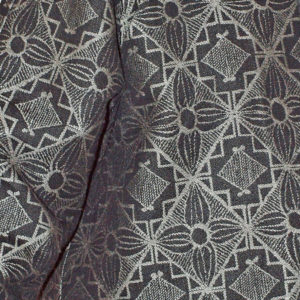 Sara learned to weave while living in Germany for 20 years. She is largely self-taught through books, lessons, observation of professional weavers, and extensive museum visits and connections (Textilmuseum Neumunster/Klaus Tidow, Freilichtmuseum [Open Air Museum], and Schleswig-Holstein in Kiel/Molfsee/Dr. Karl-Ingwer Johansson). She has always been interested in textile history and archaeology. Sara founded a group that shares weaving and weaving history with the public at Freilichtmuseum Kiel, and “descendants” of that group still work there. She has also studied drawloom weaving with Joanne Hall, Oaxacan rug weaving with Wence Martinez, Navajo weaving techniques with Sarah Natani and Mary Walker, Jacquard weaving at Oriole Mill with Bethanne Knudsen, and courses in Jacquard design at Eastern Michigan University. She weaves on countermarche looms, a 16-shaft computer-assisted dobby, a 50-pattern-shaft drawloom with eight ground shafts, and Jacquard looms. Her woven work centers on household linens and rugs, decorative items from the drawloom, and clothing fabrics and scarves. Sara is a member of the Wisconsin Handweavers, Complex Weavers, and European Damask Network. Sara owns a full service fiber shop, The Woolgatherers Ltd. in Fond du Lac, WI. she gives individual instruction in basic, intermediate, and advanced weaving, and teaches at conferences (Convergence, CW Seminars) and guilds.
Sara learned to weave while living in Germany for 20 years. She is largely self-taught through books, lessons, observation of professional weavers, and extensive museum visits and connections (Textilmuseum Neumunster/Klaus Tidow, Freilichtmuseum [Open Air Museum], and Schleswig-Holstein in Kiel/Molfsee/Dr. Karl-Ingwer Johansson). She has always been interested in textile history and archaeology. Sara founded a group that shares weaving and weaving history with the public at Freilichtmuseum Kiel, and “descendants” of that group still work there. She has also studied drawloom weaving with Joanne Hall, Oaxacan rug weaving with Wence Martinez, Navajo weaving techniques with Sarah Natani and Mary Walker, Jacquard weaving at Oriole Mill with Bethanne Knudsen, and courses in Jacquard design at Eastern Michigan University. She weaves on countermarche looms, a 16-shaft computer-assisted dobby, a 50-pattern-shaft drawloom with eight ground shafts, and Jacquard looms. Her woven work centers on household linens and rugs, decorative items from the drawloom, and clothing fabrics and scarves. Sara is a member of the Wisconsin Handweavers, Complex Weavers, and European Damask Network. Sara owns a full service fiber shop, The Woolgatherers Ltd. in Fond du Lac, WI. she gives individual instruction in basic, intermediate, and advanced weaving, and teaches at conferences (Convergence, CW Seminars) and guilds.
The Prime Numbers of Weaving—Systematic Weave Drafting and Derivation (Bindungslehre)
Bindungslehre (Swedish Bindningslara) is the study of “bindings”—This study method entails studying the interlacement diagram and working from there to a threading, tie-up, and treadling. It is based on the three ground bindings—tabby, twill, and satin.
Professional and industrial weavers have long created their drafts systematically. Weave drafts are road maps to a desired fabric. Originating with patron books of the 18th century, and later books of basic weaves and derivatives, we now have a system of ISO weaves that can be described by a standard notation. Based on the division of weave structures into plain, twill, or satin relatively complex structures can be created using this standard notation. These basic elements can then be recombined to form extremely complex cloth.
The presentation is a refresher on basic structures (interlacements) as a weaver ventures into complex cloths such as echo, networking, damask for the drawloom, lampas, beiderwand, multiple layers, and combined structures found in Jacquard weaves.
The seminar covers only single-layer weaves with a single warp and single weft, which can then be used as the starting point for more complex fabrics. Exercises on graph paper, and screen examples are created/completed using weaving software on a projection screen with the aim of fostering independence and creativity when drafting for complex projects.

